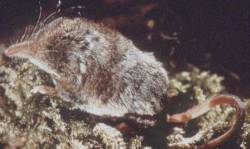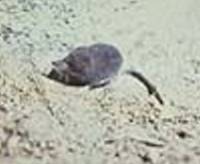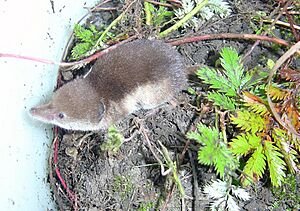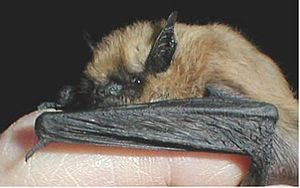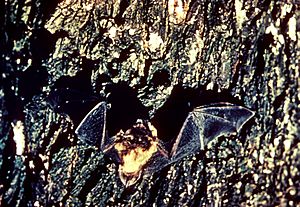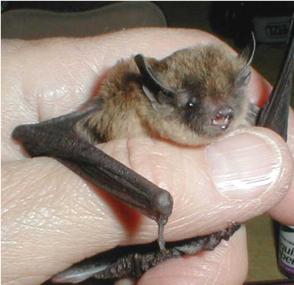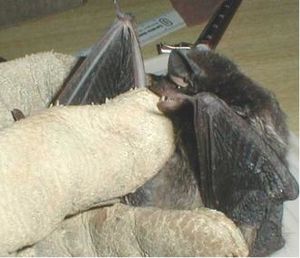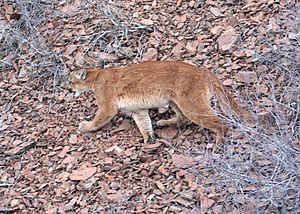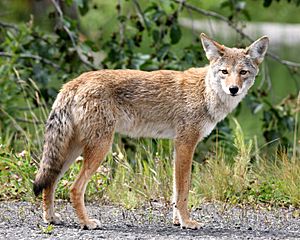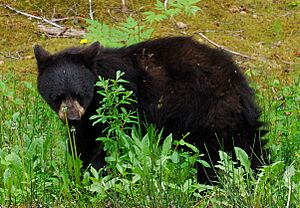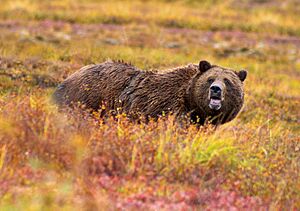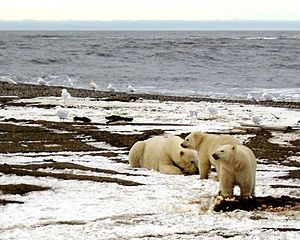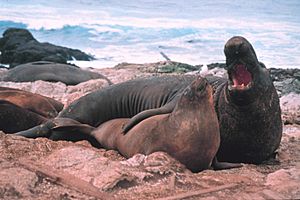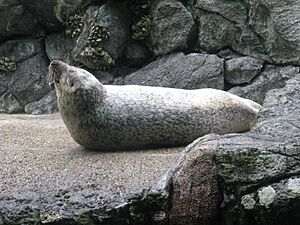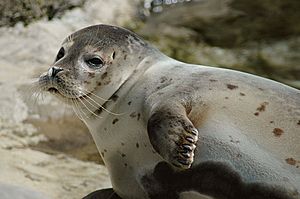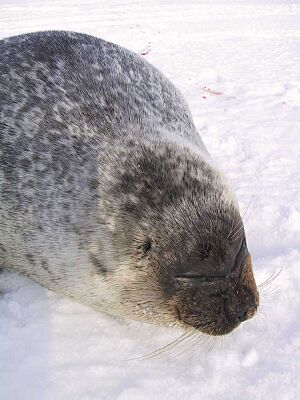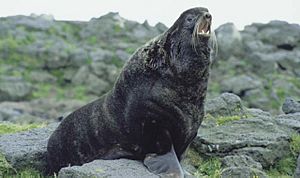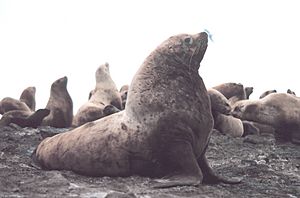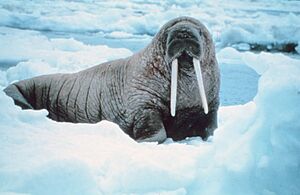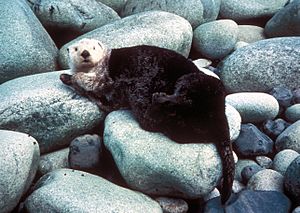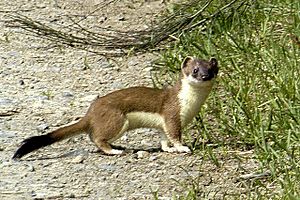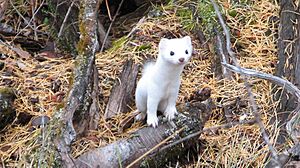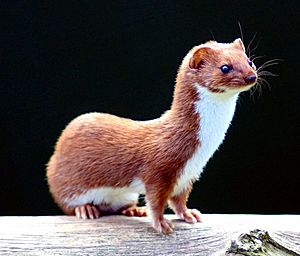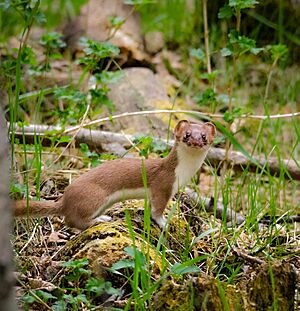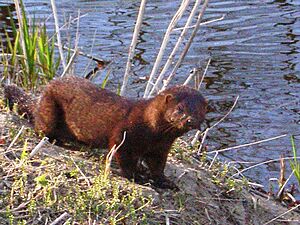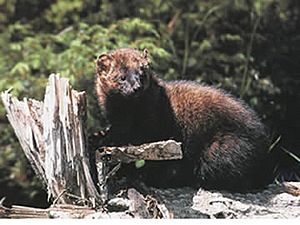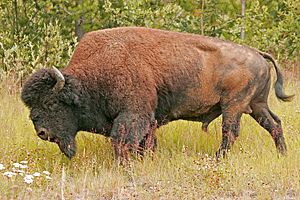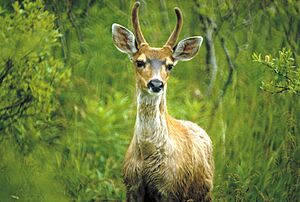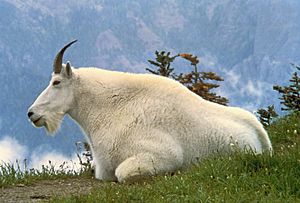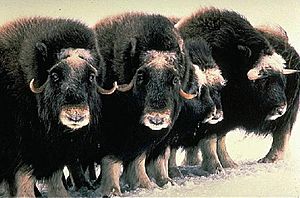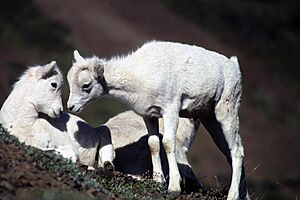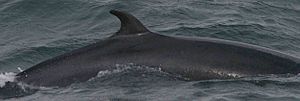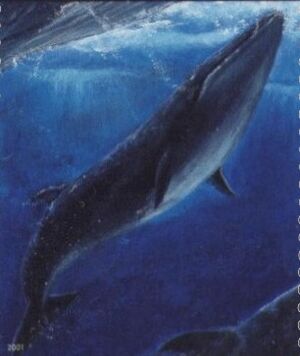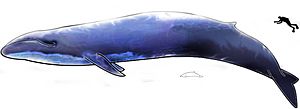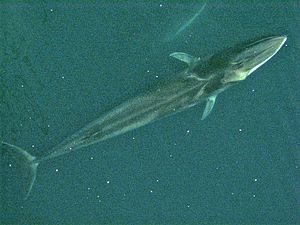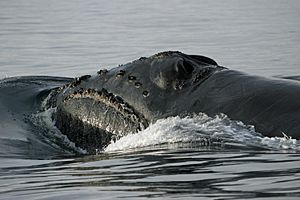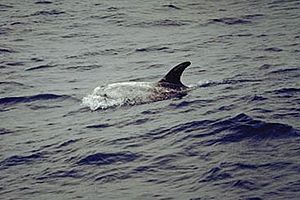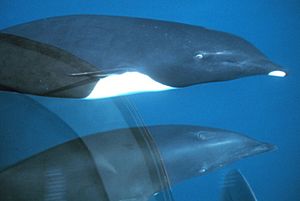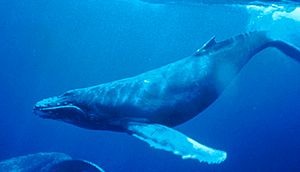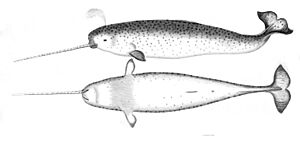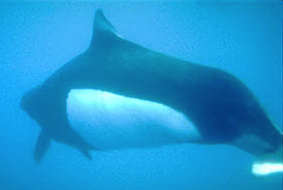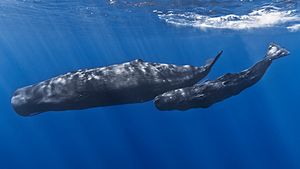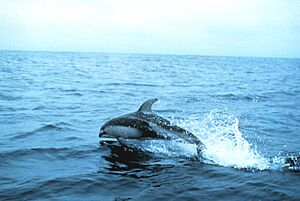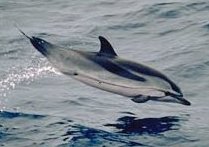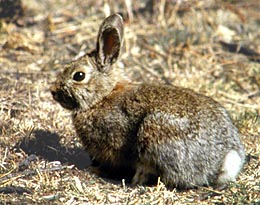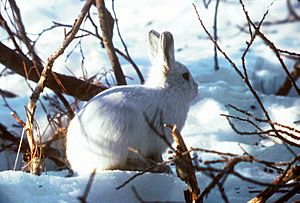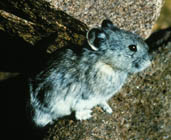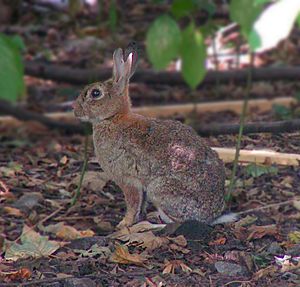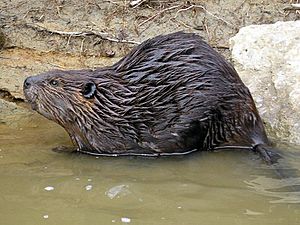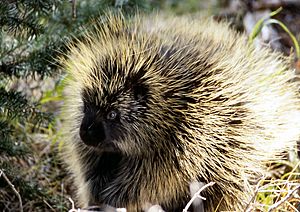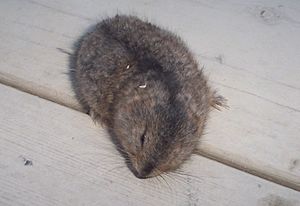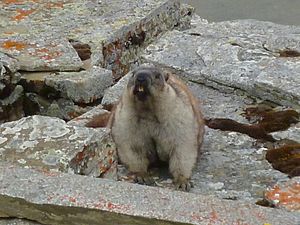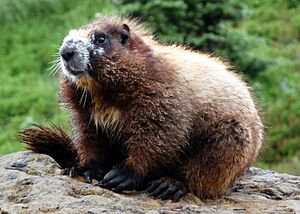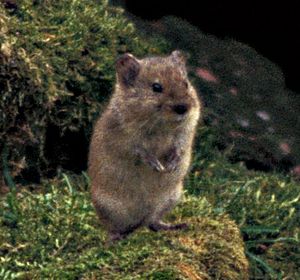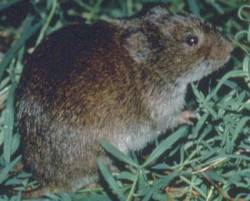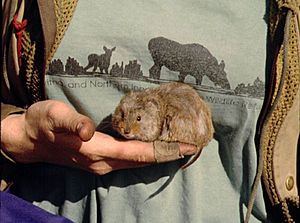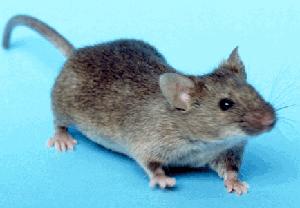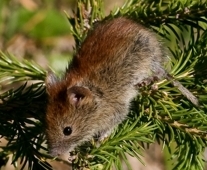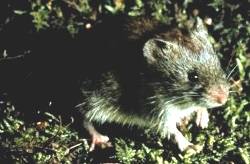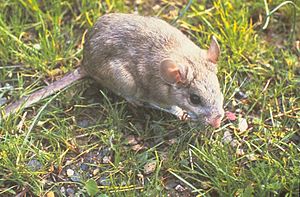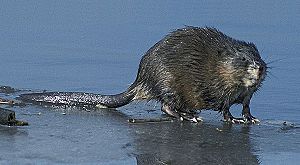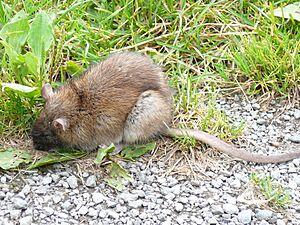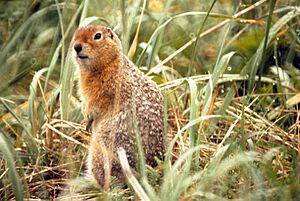List of mammals of Alaska facts for kids
Alaska is home to many different kinds of mammals, from tiny shrews to giant whales! With 112 different mammal species, Alaska has a lot of variety. This list tells you about the mammals that live in Alaska, whether they live there all the time or just visit. One animal you won't find here is the Steller's sea cow, a huge sea animal that used to live near Alaska's Aleutian Islands but was hunted until it disappeared in 1768.
This article shares the common names and scientific names for each animal. You'll also find out more about where they live and what they do. If an animal is special to Alaska, we'll tell you a bit about it. If it lives in other places too, we'll focus on what it's like in Alaska.
Contents
Tiny Insect Eaters (Eulipotyphlans)
Eulipotyphlans are small mammals that mostly eat insects. Alaska's shrews haven't been studied as much as other animals, so we don't know everything about where they live, how they have babies, or how many there are. Currently, ten types of shrews have been found in Alaska. To most people, all shrews look alike, but experts can tell them apart by where they are found and the shape of their skulls.
Shrews live all over Alaska, even on small islands. You can find them in warm, rainy forests and in cold Arctic tundra. They usually eat insects, spiders, and other small creatures. Sometimes they might eat other small animals or plants. Animals that hunt shrews in Alaska include weasels, foxes, and owls. Shrews can be helpful on farms because they eat insects, but they might also be a bother if they get into houses. None of Alaska's shrew populations are in danger, except maybe the Pribilof Island shrew.
| Species | Fun Facts | Where They Live |
|---|---|---|
| Glacier Bay water shrew Sorex alaskanus |
These shrews are found in Glacier Bay National Park and Preserve in southeast Alaska. |  |
| Common shrew Sorex cinereus |
The common shrew is one of the most widespread shrews in Alaska. It lives from the Brooks Range to Southeast Alaska. |  |
| Pygmy shrew Sorex hoyi |
The pygmy shrew lives in most of Alaska, but not in the far north (North Slope) or the southeast. | |
| Pribilof Island shrew Sorex hydrodromus |
This shrew is only found on the Pribilof Islands. |  |
| St. Lawrence Island shrew Sorex jacksoni |
The St. Lawrence Island shrew lives only on St. Lawrence Island. |  |
| Dusky shrew Sorex monticolus |
The dusky shrew is another very common shrew in Alaska. It lives from the Brooks Range to Southeast Alaska. |  |
| Water shrew Sorex palustris |
The water shrew is found in Southcentral and Southeast Alaska, up to the Alaska Range. | |
| Tundra shrew Sorex tundrensis |
Tundra shrews live in most of Alaska, but not in the southeast. | |
| Barrenground shrew Sorex ugyunak |
Barrenground shrews are found in the North Slope region of Alaska. |  |
| Tiny shrew Sorex yukonicus |
The tiny shrew seems to be found in many places in Alaska, but it's not very common. |  |
Flying Mammals (Bats)
Bats are not very common in Alaska. You'll mostly find them in Southeast Alaska, some parts of Southcentral Alaska, and in the Interior region as far north as the Yukon River.
| Species | Fun Facts | Where They Live |
|---|---|---|
| Big brown bat Eptesicus fuscus |
Only one big brown bat has ever been officially seen in Alaska. It's the largest bat in Alaska, weighing about 14 grams (half an ounce). | |
| California myotis Myotis californicus |
Like other myotis bats in Alaska, California myotis often sleep in old buildings or mines. They might also sleep alone in trees or cracks in rocks. They have been seen hibernating (sleeping through winter) in Southeast Alaska. |  |
| Keen's myotis Myotis keenii |
Keen's myotis also roost in old buildings or mines. They might sleep alone in trees or rock crevices. Scientists think they hibernate in Southeast Alaska. |  |
| Little brown bat Myotis lucifugus |
The little brown bat is the most common bat in Alaska. They often sleep in old buildings or mines, or alone in trees and rock cracks. They have been seen hibernating in Southeast Alaska and on Kodiak Island. |  |
| Long-legged myotis Myotis volans |
Long-legged myotis also roost in abandoned buildings or mines. They might sleep alone in trees or rock crevices. Scientists suspect they hibernate in Southeast Alaska. |  |
| Silver-haired bat Lasionycteris noctivagans |
After the big brown bat, the silver-haired bat is the next largest bat in Alaska. It's only found in Southeast Alaska, and only during the winter. It sleeps alone in trees. |  |
Meat Eaters (Carnivorans)
Wild Cats (Felids)
| Species | Fun Facts | Where They Live |
|---|---|---|
| Canadian lynx Lynx canadensis |
Lynx live in many parts of Alaska, but they are hard to spot because they hunt mostly at night and are very shy. Their population goes up and down with the number of snowshoe hares, which are their main food. When there are lots of hares, there are more lynx! |  |
| Cougar Puma concolor |
It's unlikely that cougars live and have babies in Alaska regularly. But people do see them sometimes, meaning some cougars wander into the state. Most sightings are in Southeast Alaska, which is close to where cougars live in British Columbia. |  |
Wild Dogs (Canids)
| Species | Fun Facts | Where They Live |
|---|---|---|
| Coyote Canis latrans |
Coyotes first appeared in Alaska in the early 1900s. They started in Southeast Alaska and spread across the state. They mostly eat snowshoe hares, small rodents, and dead animals. Wolves and bears sometimes hunt adult coyotes. | |
| Gray wolf Canis lupus |
There are five types of wolves in Alaska. Wolves in the southeast are darker and smaller than those in the north. You can find wolves on the mainland of Alaska and on most big islands in the southeast. |  |
| Arctic fox Vulpes lagopus |
Arctic foxes live in treeless coastal areas, like the Aleutian Islands and Alaska's west and north coasts. They can be white in winter and brown in summer, or charcoal-colored all year. In winter, they often eat seal leftovers from polar bears. |  |
| Red fox Vulpes vulpes |
Red foxes are found all over Alaska, except for some islands. They like marshy areas and hilly country. Where red foxes and Arctic foxes live in the same area, the red fox usually wins. Most red foxes in Alaska are red, but some can be silver or black. |  |
Bears
| Species | Fun Facts | Where They Live |
|---|---|---|
| Black bear Ursus americanus |
Black bears are smaller than Alaska's brown bears. They are found on the mainland of Alaska, but not on islands in the Gulf of Alaska. Black bears can be black, brown, cinnamon, or even a rare blue color. They often come near towns looking for food like garbage. |  |
| Grizzly bear/Kodiak bear Ursus arctos ssp. |
Alaska has most of the brown bears in the U.S. and North America! Brown bears live throughout the state, except for a few islands. Most are grizzly bears, but Kodiak Island has Kodiak bears, which are the largest brown bears and second only to polar bears in size. |  |
| Polar bear Ursus maritimus |
Alaska's polar bears live along its Arctic coastlines. In winter, they are common in the Kuskokwim Delta and near St. Matthew Island. In summer, they move to the Arctic Ocean and Chukchi Sea coasts. Efforts are being made to protect polar bears, but their populations face challenges. |  |
Seals and Sea Lions (Pinnipeds)
| Species | Fun Facts | Where They Live |
|---|---|---|
| Hooded seal Cystophora cristata |
Hooded seals usually live in the Atlantic Ocean, but sometimes they wander all the way to Alaska. | |
| Bearded seal Erignathus barbatus |
Bearded seals live in parts of the Bering, Chukchi, and Beaufort seas where sea ice forms. They can weigh over 750 pounds in winter! They usually live alone and follow the moving sea ice. Alaska Natives depend on these seals for food and hides. | |
| Ribbon seal Histriophoca fasciata |
 |
|
| Elephant seal Mirounga angustirostris |
 |
|
| Harp seal Pagophilus groenlandicus |
||
| Spotted seal Phoca largha |
 |
|
| Harbor seal Phoca vitulina |
 |
|
| Ringed seal Pusa hispida |
||
| Northern fur seal Callorhinus ursinus |
 |
|
| Steller's sea lion Eumetopias jubatus |
 |
|
| California sea lion Zalophus californianus |
Between 1974 and 2004, 54 California sea lions were seen in Alaska. | |
| Walrus Odobenus rosmarus |
 |
Weasel Family (Mustelids)
| Species | Fun Facts | Where They Live |
|---|---|---|
| Sea otter Enhydra lutris |
Sea otter fur is very valuable. They were hunted almost to extinction in the late 1800s. Thanks to protection, their numbers grew from 2,000 to over 100,000 by the 1970s. Today, they have returned to most of their old homes in Alaska. |  |
| Wolverine Gulo gulo |
Wolverines live in remote parts of mainland Alaska and some islands in Southeast Alaska. They need a lot of wild space. Wolverines are usually alone, except when they are having babies. They are good at finding food, often eating dead animals or small creatures like voles and squirrels. | |
| North American river otter Lontra canadensis |
River otters are found all over Alaska, except for the Aleutian Islands, some Bering Sea islands, and the Arctic coast. | |
| American marten Martes americana |
American martens are common in Alaska, from Southeast Alaska to the treeless tundra. They are most common in interior Alaska's forests. They eat voles, berries, small birds, eggs, and dead animals. They are the most trapped animal in Alaska. | |
| Pacific marten Martes caurina |
||
| Beringian ermine Mustela erminea |
Found in almost all of Alaska, except for some islands in the southeast. | |
| Haida ermine Mustela haidarum |
Found in the Alexander Archipelago. | |
| Least weasel Mustela nivalis |
||
| American ermine Mustela richardsonii |
Found in some parts of southeast Alaska. | |
| Mink Neogale vison |
Mink live in every part of Alaska except Kodiak Island, the Aleutian Islands, Bering Sea islands, and most of the North Slope. They eat almost anything they can catch, like fish, birds, eggs, insects, and small mammals. | |
| Fisher Pekania pennanti |
Hoofed Animals (Even-toed Ungulates)
These are mammals that have an even number of toes and usually have hooves.
| Species | Fun Facts | Where They Live |
|---|---|---|
| Moose Alces alces |
The Alaska subspecies of moose is the biggest in the world! Adult males can weigh 1,200 to 1,600 pounds. Their population is controlled by predators like bears and wolves, who mostly hunt young moose, and by hunters. |  |
| Wood bison Bison bison athabascae |
The American bison was brought back to Alaska in 1928. In 2003, there were about 900 wild bison. Another type of bison, the wood bison, is also being brought back to the wild in Shageluk, Alaska. |  |
| Elk Cervus canadensis |
Elk are not originally from Alaska; they were introduced. The elk in Alaska are the Roosevelt elk type. They are found in the southern tip of Alaska. |  |
| Sitka deer Odocoileus hemionus sitkensis |
 |
|
| Caribou Rangifer tarandus |
Alaska has a special type of caribou. Caribou usually live in tundra and mountains where there are few trees. But many herds spend winters in the boreal forest. There are about 950,000 caribou in Alaska, and their numbers are controlled by predators and hunters. |  |
| Mountain goat Oreamnos americanus |
Mountain goats live in the rugged, rocky mountains of Alaska, especially in the Southeast and along the Coast Mountains. They move between high alpine ridges in summer and lower tree-lines in winter. |  |
| Muskox Ovibos moschatus |
Muskox were brought back to Alaska after they died out in the state. You can now find them in several wildlife refuges and parks, and they have also been brought back to Yukon. |  |
| Dall sheep Ovis dalli |
Dall sheep live in the rocky, steep mountain areas of Alaska. This mountain home helps them stay safe from predators and people. Alaska has a good number of these thinhorn sheep. |  |
Whales and Dolphins (Cetaceans)
These are marine mammals that live entirely in the water.
| Species | Fun Facts | Where They Live |
|---|---|---|
| Bowhead whale Balaena mysticetus |
The bowhead whales in the Bering Sea are the only large group left, after a lot of commercial whaling. They travel a long way, wintering in the Bering Sea and moving to the Canadian Beaufort Sea for summer. For Alaskan Inuit people, bowhead whales are very important for food and culture. |  |
| Minke whale Balaenoptera acutorostrata |
 |
|
| Sei whale Balaenoptera borealis |
 |
|
| Blue whale Balaenoptera musculus |
Blue whales are the largest animals on Earth! They are rare north of the Bering Sea. You might see them in Alaska during the summer. They usually stay in deep waters, not close to shore. Their numbers are much lower than they used to be because of whaling. |  |
| Fin whale Balaenoptera physalus |
 |
|
| Beluga whale Delphinapterus leucas |
In summer, belugas eat different kinds of fish. They can live in the ocean but also swim up large rivers like the Yukon. There are two groups of belugas in Alaska: a smaller group in Cook Inlet and a much larger group in the Bering Sea. Alaska Natives hunt a small number of belugas for food and oil. |  |
| Gray whale Eschrichtius robustus |
 |
|
| North Pacific right whale Eubalaena japonica |
 |
|
| Short-finned pilot whale Globicephala macrorhynchus |
 |
|
| Risso's dolphin Grampus griseus |
 |
|
| Northern right-whale dolphin Lissodelphis borealis |
||
| Humpback whale Megaptera novaeangliae |
Humpback whales are often seen in Alaska during the summer. Most of them spend winter in Hawaii. In Alaska, they eat herring, other small fish, and krill. Their main predators are killer whales and humans. |  |
| Stejneger's beaked whale Mesoplodon stejnegeri |
||
| Narwhal Monodon monoceros |
Narwhals are sometimes seen in Alaska waters, but they are not common residents. |  |
| Killer whale Orcinus orca |
Killer whales, also known as orcas, are powerful hunters. They are known to hunt other whales and large prey like seals and sea lions. Orcas are found along the coast from Southeast Alaska through the Aleutian Islands. |  |
| Harbor porpoise Phocoena phocoena |
 |
|
| Dall's porpoise Phocoenoides dalli |
 |
|
| Sperm whale Physeter macrocephalus |
 |
|
| 'Pacific white-sided dolphin Sagmatias obliquidens |
||
| Cuvier's beaked whale Ziphius cavirostris |
 |
|
Hares and Pikas (Lagomorphs)
These are small, furry mammals with long ears and strong hind legs.
| Species | Fun Facts | Where They Live |
|---|---|---|
| Snowshoe hare Lepus americanus |
The snowshoe hare is the most common hare in Alaska. They live in brushy areas and forests. Their numbers go up and down a lot, and in peak years, there can be many hares per square mile! They are a key food source for many of Alaska's furbearing animals, especially lynx. |  |
| Tundra hare Lepus othus |
The tundra hare is mostly found on Alaska's western coast. It prefers rocky slopes and open tundra, avoiding lowlands and forests. They are important for hunting and fur trapping. |  |
| Collared pika Ochotona collaris |
 |
|
| European rabbit Oryctolagus cuniculus |
These rabbits were brought to Alaska by people. You can find them in and around some towns and cities. |
Gnawing Animals (Rodents)
Rodents are mammals with continuously growing incisors in the upper and lower jaws which must be kept short by gnawing.
| Name | Fun Facts | Where They Live |
|---|---|---|
| Beaver Castor canadensis |
||
| Northern collared lemming Dicrostonyx groenlandicus |
 |
|
| Nelson's collared lemming Dicrostonyx nelsoni |
||
| Unalaska collared lemming Dicrostonyx unalascensis |
||
| Porcupine Erethizon dorsatum |
Porcupines are the largest rodents in Alaska, besides beavers, weighing about 15 pounds. They are found everywhere in Alaska except the Alaska Peninsula and some islands. In winter, they eat tree bark. Their quills protect them from most predators, but some animals like fishers and wolves have learned how to hunt them. | |
| Northern flying squirrel Glaucomys sabrinus |
||
| North American brown lemming Lemmus trimucronatus |
||
| Alaska marmot Marmota broweri |
The Alaska marmot lives in the rocky slopes of the Brooks Range, which protect them from predators. They eat grass, plants, berries, and moss. They have special winter dens where they hibernate from September to May. Alaska Natives traditionally hunted marmots for food and fur. |  |
| Hoary marmot Marmota caligata |
 |
|
| Woodchuck Marmota monax |
||
| St. Matthew Island vole Microtus abbreviatus |
Not many people have seen the St. Matthew Island vole because it only lives on St. Matthew Island and nearby Hall Island, which are hard to reach. They live in damp lowlands and on grassy beaches. They are active during the day and eat plants. Birds and Arctic foxes hunt them. |  |
| Long-tailed vole Microtus longicaudus |
Long-tailed voles are found throughout Southeast Alaska, the Yakutat forelands, and the far eastern Interior. | |
| Singing vole Microtus miurus |
We don't know exactly where all singing voles live. They have been found in the North Slope, Seward Peninsula, Brooks Range, and Alaska Range, but not in the Interior or Southeast. |  |
| Tundra vole Microtus oeconomus |
||
| Meadow vole Microtus pennsylvanicus |
||
| Yellow-cheeked vole Microtus xanthognathus |
||
| House mouse Mus musculus |
These mice were brought to Alaska by people. | |
| Northern red-backed vole Myodes rutilus |
Northern red-backed voles are found throughout mainland Alaska, and on Unimak Island and St. Lawrence Island. They are not found in Southeast Alaska, Kodiak, or Nunivak Island. |  |
| Southern red-backed vole Myodes gapperi |
 |
|
| Bushy-tailed woodrat Neotoma cinerea |
||
| Muskrat Ondatra zibethicus |
 |
|
| Forest deer mouse Peromyscus keeni |
||
| Western deer mouse Peromyscus sonoriensis |
These mice were brought to Alaska by people. | |
| Western heather vole Phenacomys intermedius |
The first western heather vole in Alaska was found in 1999 near Hyder, Alaska. |  |
| Norway rat Rattus norvegicus |
These rats were brought to Alaska by people. | |
| Arctic ground squirrel Spermophilus parryii |
||
| Northern bog lemming Synaptomys borealis |
||
| Red squirrel Tamiasciurus hudsonicus |
||
| Meadow jumping mouse Zapus hudsonius |
||
| Western jumping mouse Zapus princeps |
See also
- Wildlife of Alaska
- List of mammals
- List of regional mammals lists


